الأسواق
عند تصميم تدخل إنساني وتحديد ما إذا كان سيتم استخدام المساعدات النقدية والقسائم، يجب أن يكون تحليل السوق جزءًا من تحليل الاستجابة الشامل. وثبت أن دعم الأسواق للعمل بشكل جيد يؤدي إلى تعافي أسرع وزيادة المرونة في المناطق المتضررة من الكوارث.
واستثمرت العديد من المنظمات في تطوير أدوات لدعم تحليل السوق وتفكر في البرمجة القائمة على السوق بشكل أكثر شمولية. يشمل ذلك التدخلات التي تستخدم السوق (مثل التحويلات النقدية إلى السكان المتضررين)، بالإضافة إلى التدخلات التي تدعم الأسواق بشكل مباشر (مثل المنح المشروطة للمتداولين لإعادة تشغيل أسواقهم).
Related initiatives
Featured content

Introduction to Market Analysis
دورة تدريبية
This 30 minute online course provides an introduction to the analysis of markets in emergency contexts, with input from some of the world’s leading thinkers on the topic.

A Practical Guide to Market Analysis in Humanitarian response
دورة تدريبية
A three to four hour online course designed to provide future humanitarian market assessment team members with a solid understanding of theory and steps of market assessments so that they can join assessment teams prepared with a basic understanding of what they will be doing and why.
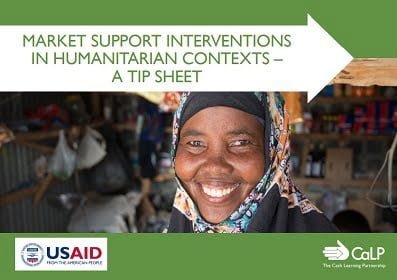
Market Support Interventions in Humanitarian Contexts – a Tip Sheet
Guidelines and Tools
This tip sheet defines what market support programming in humanitarian contexts is, and what it can look like in practice. It enables humanitarian practitioners to systematically consider market support interventions alongside other programme activities. The scope includes support interventions focusing on supply/availability and on demand/access. The tip sheet is based on secondary data...
Latest
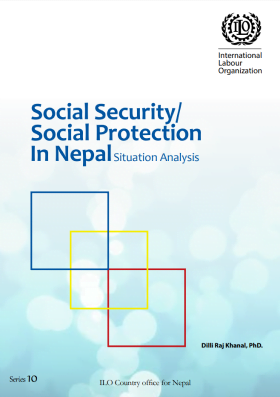
Social Security/Social Protection In Nepal: Situation analysis
Report
The International Labour Conference has outlined several strategies to extend social security by closing coverage gaps and pointed out that effective national strategies should be formed in line with national priorities, administrative feasibility and affordability. The primary goal is to ensure that no...

Final Evaluation Report of the Wet Feeding and Cash Transfer Project in Southern Somalia
Report
This evaluation report details the achievements of the ECHO funded Wet Feeding and Resource Transfer project implemented by Danish Refugee Council in Mogadishu and ended on March 30th. This synopsis precedes the details of the project and the evaluation as contained in the report. The wet feeding...
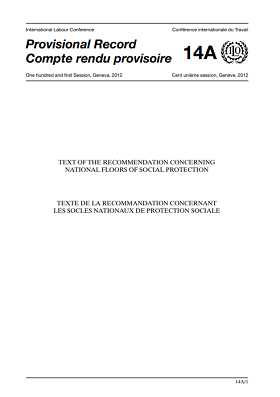
Text of the Recommendation Concerning National Floors of Social Protection
Report
Further to the International Labour conference 101st session, the International Labour Organization adopted a new international work. Recommendation concerning the implementation of quick national social protection floors and the progressive extension of social safety for all. Social protection floors are...
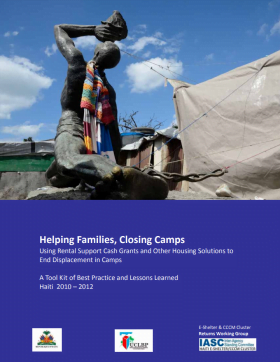
Helping Families, Closing Camps: Using rental support cash grants and other housing solutions to end displacement in camps
Guidelines and Tools
Rental Support Cash Grants have enabled over 14,000 families to move from Haiti’s displacement camps into safe housing. Since October 2010, ten months after the January 12th earthquake, these grants of $500 US Dollars covering one year of rent have proven to be a fast, effective and relatively...

Emergency Food Security and Livelihoods (EFSL) 48-hour Facilitator’s Materials
Guidelines and Tools
Developed by Oxfam and supporting ECB agencies, the EFSL training materials can be used to train participants to confidently apply the ‘48-hour assessment tool’ to assess the impact of a shock/hazard on an affected population’s food security and livelihoods. The Facilitator Materials include session...
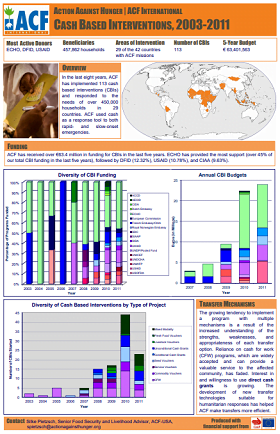
ACF Cash-based Interventions 2003-2011 (Poster)
Report
A one-pager / poster showing ACF’s cash-based interventions between 2003-2011, showing source of funding and type of intervention.
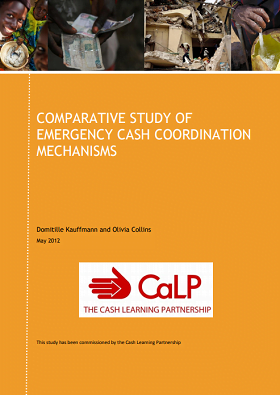
Comparative Study of Emergency Cash Coordination Mechanisms
Report
Based principally on three cases studies (Pakistan, Haiti, and the Horn of Africa), the objective of this comparative study is to draw on lessons learnt for better coordination of cash transfer programmes (CTP) in future emergencies. This study has been commissioned by the CALP Network and conducted by...

Emergency Food Security and Livelihoods (EFSL) 48-hour training materials to print
Guidelines and Tools
Developed by Oxfam and supporting ECB agencies, the EFSL training materials can be used to train participants to confidently apply the ‘48-hour assessment tool’ to assess the impact of a shock/hazard on an affected population’s food security and livelihoods. This resource includes all printing...
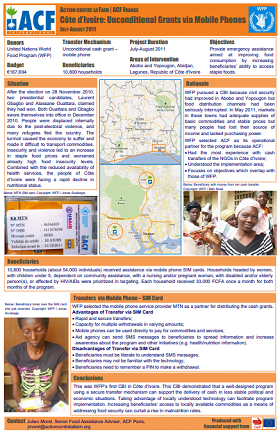
ACF Côte d’Ivoire: Unconditional grants via mobile phones (poster)
Report
This one-pager (poster) provides an overview of ACF’s experience transferring cash by mobile phone in the Ivory Coast (a WFP programme).

Impact Evaluation of Cash, Food Vouchers, and Food Transfers among Colombian Refugees and Poor Ecuadorians in Carchi and Sucumbíos
Report
This report is the final impact evaluation of the World Food Programme’s Food, Cash, and Voucher intervention and contains analysis on outcomes including food security, social capital, anemia, and gender issues. Due to the targeting of Colombian refuges and poor Ecuadorians in Northern Ecuador, it also...

ACF Meta Evaluation: Fresh food vouchers (poster)
Report
This one-page poster shows a summary of the meta evaluation of 5 Fresh Food Voucher programmes in Bolivia, Haiti, Daadab Kenya, the oPT and Pakistan.

Comparing the Efficiency, Effectiveness and Impact of Food and Cash for Work Interventions: Lessons Learned from South Sudan
Report
In addition to food aid, which used to be the standard response to food emergencies, alternative instruments of food assistance such as cash and vouchers have increasingly been applied in emergency and transition situations in recent years. The subject of the present study was a comparative analysis of...
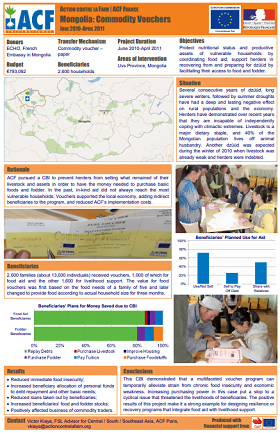
ACF Mongolia Commodity Vouchers (Poster)
Report
This one-page poster provides an overview of ACF’s commodity voucher programme in Mongolia.
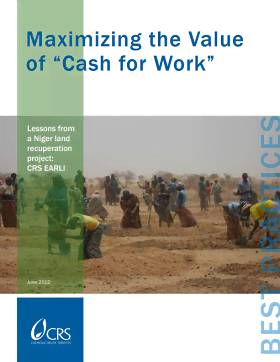
Maximizing the Value of "Cash for Work": Lessons from a Niger land recuperation project
Report
The good practices in this publication were distilled from a Real Time Evaluation (RTE) of an emergency project in Niger, implemented by Catholic Relief Services (CRS) and financed by OFDA that is using cash for work and seed fairs to address food insecurity in the departments of Ouallam and...

Cash transfer programming in urban emergencies: a toolkit for practitioners
Guidelines and Tools
In recognition of the increasing urban populations around the world and their increasing vulnerability to disasters, the the CALP Network endeavored to investigate the current status and impact of urban emergency response programs that utilise cash transfer programming. This study aims to better...
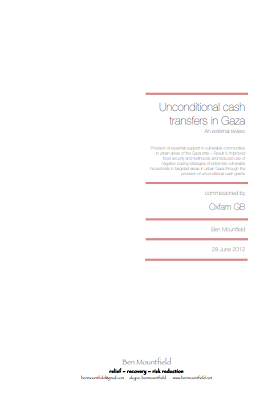
Unconditional cash transfers in Gaza: an external review
Report
This is a review of small pilot project, which targets extremely vulnerable households with monthly unconditional cash transfers for a limited period. The target population is made up of two groups, one group already receiving assistance through a voucher from WFP but still showing poor food diversity...

Cash Transfers in Nairobi’s Slums
Report
In Kenya, a combination of factors led to the food crisis of 2008–9, which put around 9.5 million people at risk of starvation. About 4.1 million of those affected were living in informal settlements (slums) in the capital, Nairobi. Oxfam and Concern Worldwide developed a joint programme to address...

Cash and Shelter: A Workshop on Using Cash Transfer Programming for Emergency and Early Recovery Shelter
Presentation
A power point presentation to provide guidance to programme managers, programme implementers and programme support staff when selecting cash as a potential response tool in emergency shelter programmes.
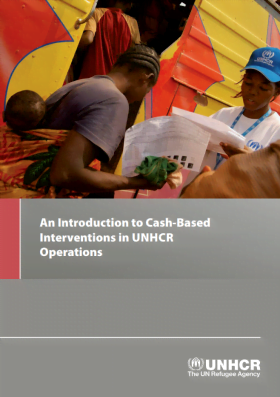
An Introduction to Cash-Based Interventions in UNHCR Operations
Policy paper
This document provides an introduction and basic guidance on the use of cash-based interventions and tackles key issues of relevance to UNHCR in the form of questions and answers. It also provides an overview of UNHCR’s experience in using cash-based interventions.
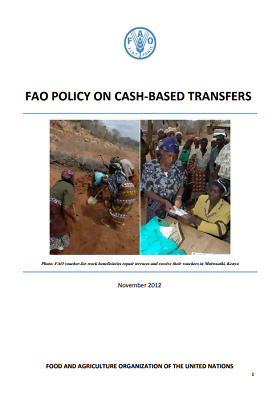
FAO Policy on Cash-Based Transfers
Report
This document articulates FAO’s roles with respect to supporting and implementing CTs linked to agriculture and food security in line with the Organization’s mandate and comparative advantages. It is based on FAO’s experience and expertise in supporting CT programming and details various CT...